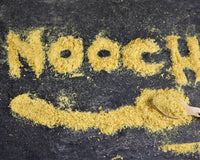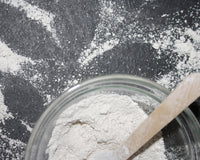Diatomaceous Earth
Using Diatomaceous Earth to store dry goods is not a novel concept. Several ancient cultures used to mix DE into their grain stores to protect them from insects. This ancient practice is still carried on in agricultural practices today where farmers and warehouses mix DE into their grain and animal feed. Diatomaceous Earth can also be used to help preserve food storage items such as flour, legumes, rice, pulses, or any other dry foods. Not only can DE deter and exterminate any unwanted insects, but Diatomaceous Earth is also great at absorbing moisture, keeping the food dry and mold-free. It also serves as a flow aid and anti-caking agent. This is especially helpful with any feeds and products that experience any difficulty with flowing and pouring. This is particularly helpful with any wet feeds or feeds abundant in molasses. Diatomaceous Earth helps to coat it, break it up and keep them from sticking together. Use food-grade DE in your cereal, oatmeal, pasta and other shelf items. You can even cook your DE treated items without having to worry about it hindering its taste, as DE is tasteless. The very best part, DE is entirely natural, helping to eliminate any need for artificial preservatives or nasty chemicals!
Freezing
Another popular food preservation method used is freezing. Ideal for increasing longevity, zero chance of finding any pests or mold (assuming your freezer is functioning properly). While a couple of these claims may be true, this is not so for longevity increase. This is because after some time the taste and quality of the product decrease due to the cold. The amount of time your grains remain fresh at home largely depends on how much of their shelf life has already been used up during shipping, at the warehouse and in the shop, before bringing them home. Here are some guidelines that may help you with your grain storage journey.
|
Whole Grain Flour/Meal |
Intact Whole Grain (still has the bran) |
|
|
Amaranth |
Pantry: 2 months Freezer: 4 months |
Pantry: 4 months Freezer: 8 months |
|
Barley |
Pantry: 3 months Freezer: 6 months |
Pantry: 6 months Freezer: 1 year |
|
Brown/coloured rice |
Pantry: 3 months Freezer: 6 months |
Pantry: 6 months Freezer: 1 year |
|
Buckwheat |
Pantry: 1 month Freezer: 2 months |
Pantry: 2 months Freezer: 4 months |
|
Popping Corn/ Corn |
Pantry: 3 months Freezer: 6 months |
Pantry: 6 months Freezer: 1 year |
|
Millet |
Pantry: 1 month Freezer: 2 months |
Pantry: 2 months Freezer: 4 months |
|
Oats |
Pantry: 2 months Freezer: 4 months |
Pantry: 4 months Freezer: 8 months |
|
Quinoa |
Pantry: 2 months Freezer: 4 months |
Pantry: 4 months Freezer: 8 months |
|
Rye |
Pantry: 3 months Freezer: 6 months |
Pantry: 6 months Freezer: 1 year |
|
Spelt |
Pantry: 3 months Freezer: 6 months |
Pantry: 6 months Freezer: 1 year |
|
Wheat |
Pantry: 3 months Freezer: 6 months |
Pantry: 6 months Freezer: 1 year |
|
Wild Rice |
Pantry: 2 months Freezer: 4 months |
Pantry: 4 months Freezer: 8 months |
Salt
Using salt as a preserving method is another way to promote the longevity of some foodstuffs. This method is generally reserved for the preservation of different meats and fish. This is known as curing or salt curing. Further to its preservation properties salt curing contributes the element of flavour. Some also regard salt as a powerful deterrent for microbial growth however, the actual levels of salt required to promote this would be too high for the body to handle.
Vacuum Sealing
When it comes to food preservation using a vacuum sealer can be one of the best ways to keep food fresh longer, be it in the pantry, fridge or freezer. Producing a vacuum means removing all the oxygen from the contents of a package. This helps reduce the rate of bacterial growth whilst curbing oxidative rancidity of fats in foods. However, the elimination of oxygen does not necessarily eliminate the possibility for all bacterial growth. Some types of pathogens (illness-causing bacteria) prefer a vacuum environment as this eliminates the competition from spoilage bacteria they can reproduce even more rapidly. Many of whom use vacuum sealing as a form of preservation double up by freezing the vacuumed packs as well. Providing an even ‘safer’ shelf life for some products. Flours and rice can last from 1-2 years frozen when vacuum sealed!
Cool, Dry Conditions
A cool dry place usually refers to a pantry, drawer or closed cabinet where the temperature stays between 8-15 degrees Celsius where the relative humidity is about 80%. This is a common instruction found on the back of most dry food packaging. In order to maximise the life of packaged goods make sure to keep them away from sunlight and any common heat source from your kitchen. These include hobs, ovens and any areas surrounding the refrigerator. Contrary to popular belief the areas surrounding the refrigerator and the top of it are quite warm. This is because fridges are constantly at work removing heat from its internal cooling cabinets and releasing it into the room outside. The best bet is to store your packaged goods in a cool, dry and closed space.
Citric Acid
Citric Acid is another quick fix for food preservation at home. However its use is more prevalent with freshers foods. If you're having a large party of people coming over and you don’t want your big bowl of guacamole to brown while you wait for everyone to get there. Sprinkle a bit of citric acid in your guac and voila! It won't brown. The same is true for apple slices, still want them to look crisp and fresh for a packed lunch or a serving platter? Sprinkling some citric acid over the top and you’ll have that perfect slice look for longer.
In Conclusion
There are many different ways in which one can aim to lengthen the shelf life of one's dry products. It is only a matter of choosing which method suits you and your product's needs best.






